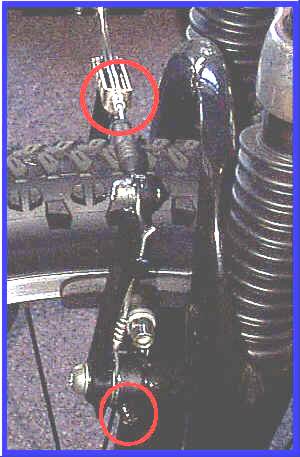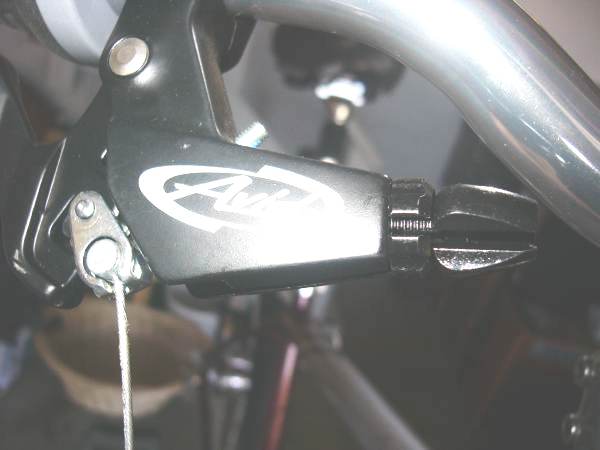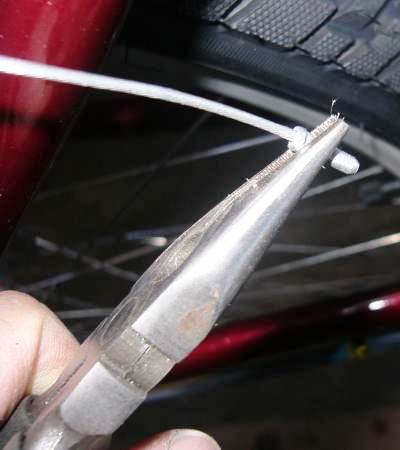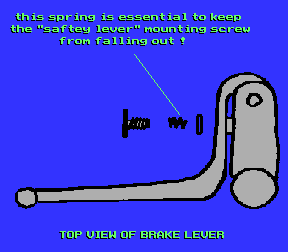"Save Big With Bicycle Discount Coupon Codes"
Bicycle Tune-Up Step 6 - Adjust The Bikes Brakes II

This brake, representing a very common style, can be opened quickly without tools for removal of the front wheel. Squeeze the brake together and then lift the cable casing out of the clip on right side caliper. To center this brake, tighten or loosen the small screw (Allen or Plillips head, depending on the model). The little screw pushes against the brake caliper return spring, causing the caliper to pull back harder on this side when the screw is tighter.
![]()
Examine the brake cables for fraying. Look carefully at the part of the inner wires connected into the hand levers. A cable with even one broken strand is not reliable.
Replacing a cable is easy. At the bike shop you can buy a universal cable. It will be long enough for any bike, and may have two ends on it, one of which will fit any bike.
Using sharp diagonal or wire cutters, cut off the end that does not fit your bike. Pull the inner wire entirely out of the housing (sometimes called "casing"). Lay the housing against your bike and cut it to the proper length. Make sure to allow enough length that the handlebars can be turned fully to either side.

Cover the inner wire with grease, then slide it into the housing. Hook the inner wire into the hand lever, then have an assistant or a clamp (available at bike shops, called "third hand tool") squeeze the brake caliper while you pull the slack out of the cable wire and tighten the holding bolt.
Squeeze the hand lever hard, then loosen the holding bolt, pull more slack out of the inner wire and retighten. Fine adjustment is made by turning the adjusting barrel. Test your work by squeezing the hand lever hard. The cable should not slip.
Cut off excess cable wire at least one inch beyond the holding bolt. This will leave you something to pull on the next time you adjust the brake. Solder the end or put a little cap, called a cable ferrulle, on the end of the wire to keep it from unraveling. Ferrulles are available at bike shops which fit over the end of the inner wire, and are squeezed with pliers to fasten them on. Solder is preferable because the cable can be removed and reinstalled without changing the tip, and the solder can't fall off. To solder effectively:
1. If the soldering iron tip is not covered with clean, shiny solder, sand it clean, heat it up, and apply fresh flux and solder to cover the tip.
2. Let the iron heat fully, and apply a bit of solder.
3. Touch the wet solder on the tip of the iron to the inner wire. The wet solder makes greater contact than a dry tip, so the heat will transfer better.
4. Wait until solder touched to the other side of the wire melts, and let it flow in among the strands. Flick the wire (while wearing goggles) if you have an excess blob to shake off.
Use rosin-core, not acid-core solder. Note that solder won't stick to stainless steel wires, unless you use special stainless solder.
In case you are wondering about the difference between a soldering iron and a soldering gun: An iron is generally long and thin, has no on/off switch, and is left plugged in and always warm but takes a while to warm up. A soldering gun has a trigger switch and heats up quickly when the trigger is squeezed. I prefer to use a gun to avoid hot clutter on my bench, but used an iron in the picture below.


![]()
The Brake Pads
Look at the brake pads. If they are not new-looking, replace them with good quality pads. Expensive ones work best, and the difference can be dramatic, well worth the difference in price. The single most effective improvement in a poor bicycle braking system is to put on the best brake pads you can get.
![]()
Diagnosing Brake Stickiness
The most common brake problem is that the brake does not open well after being squeezed.
Apply the brake, not from the hand lever, but by squeezing the caliper itself. If it opens well, the problem is not in the caliper. Squeeze the brake caliper again and with your other hand squeeze the brake hand lever. Let go of the hand lever, but not the brake caliper. Can you move the hand lever easily? If so the problem is in the cable.
If the brake lever is stiff, disconnect the cable to be sure the problem is isolated in the hand lever. A stiff hand lever can sometimes be fixed by applying careful pressure laterally, to free up the pivot. Oil sometimes helps and never hurts if used in a very small quantity.
![]()
Hand Levers
Hand levers found on some ten-speed bikes with low curved handlebars sometimes cannot be mounted securely because the brake levers' mountings do not fit the diameter of the handlebar. The best repair is to replace the handlebar or the brake levers.
Extension levers (also known as "safety levers") often have adjustable pivots. You may leave their mounting screws loose if there are springs inside the pivot posts to keep the bolts from unscrewing due to vibration.

Extension ("Safety") Levers
3 Things You Need To KnowBefore You Buy
![]()
Back - Adjust The Bike's Brakes I
Next - Rear Derailleur Adjustment
Tell a Friend About BikeWebSite
Please feel free to link your web pages to www.bikewebsite.com.
![]()
Copyright © 1991-2014, bikewebsite.com